- E-mail:BD@ebraincase.com
- Tel:+8618971215294
Gene therapy is a breakthrough medical strategy that aims to treat inherited and acquired diseases through gene replacement, silencing, or editing. In recent years, recombinant adeno-associated virus (rAAV) has become an important tool in the field of gene therapy due to its unique biological characteristics. rAAV has broad tissue tropism, low pathogenicity and immunogenicity, and its ability to achieve long-term transgene expression, which makes it show great potential for clinical applications. However, with the widespread application of rAAV gene therapy, the safety of high-dose viral therapies has gradually attracted attention, including side effects such as immune response, genotoxicity, hepatotoxicity, thrombotic microangiopathy (TMA), and neurotoxicity. These challenges not only affect the safety and efficacy of treatments, but also put forward new requirements for the future development of gene therapy.
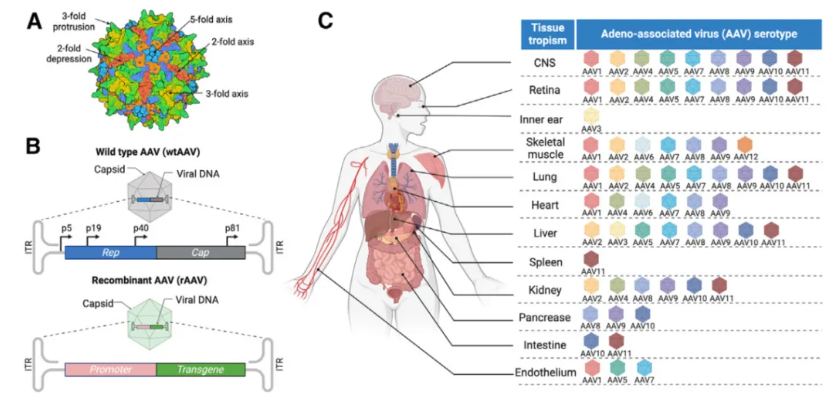
There are two main delivery methods of gene therapy: ex vivo and in vivo. Ex vivo gene therapy involves extracting cells from a patient, modifying them and then re-infusing them into the patient, while in vivo gene therapy delivers genetic material directly to the target tissue. Currently, 14 ex vivo and 29 in vivo gene therapies have been approved by the FDA, with viral vector-based gene therapies dominating. Among these viral vectors, AAV has become the vector of choice for clinical trials and FDA-approved applications due to its non-pathogenicity, low risk of genomic integration, and long-term transgene expression ability.
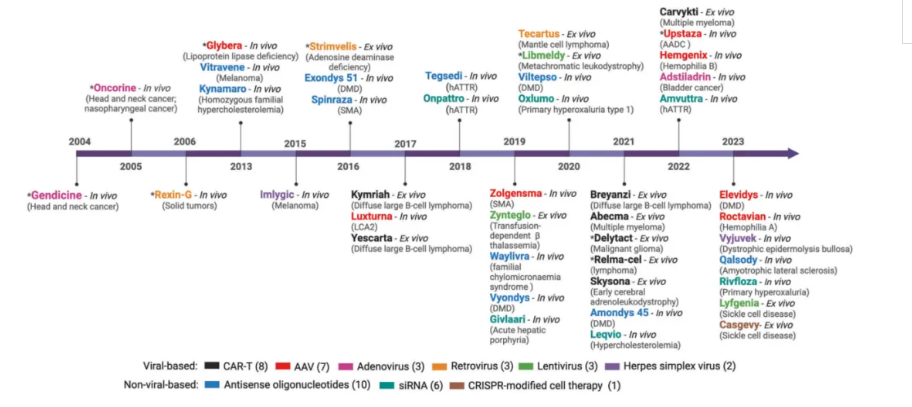
Figure 2: Approved gene therapy products and delivery platforms
Over the past few decades, significant progress has been made in the clinical use of rAAV, particularly in the treatment of ophthalmic, neurological, metabolic, hematological, neuromuscular, cardiovascular, and neoplastic diseases. These studies not only demonstrate the therapeutic potential of rAAV in a variety of diseases, but also provide an important reference for the future development of gene therapy.
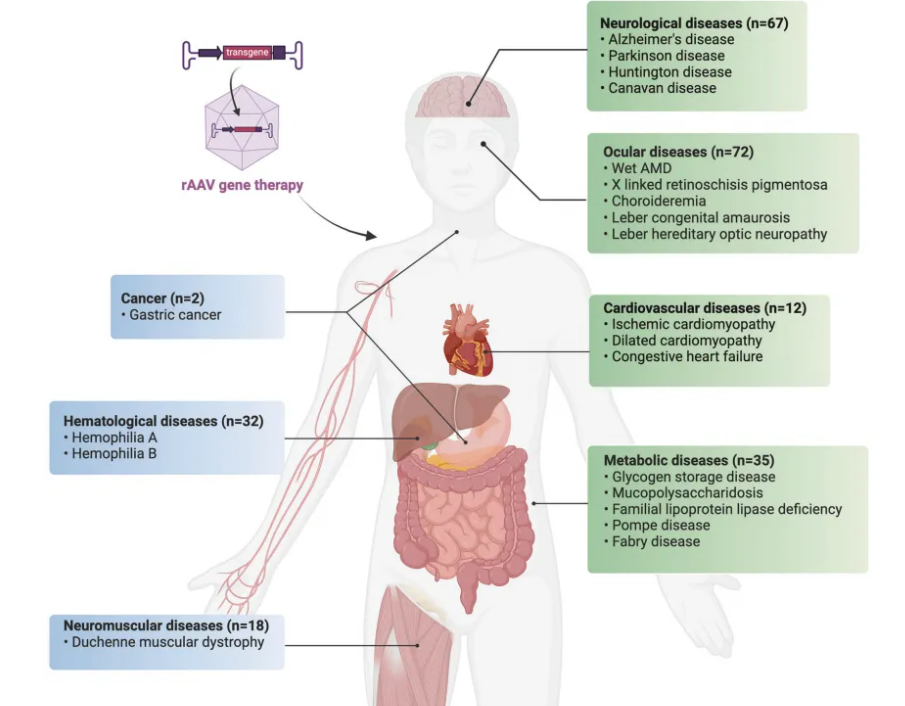
Figure 3: Current status of rAAV in major human diseases
🎗Leber Congenital Aurosis Type 2 (LCA2)
Luxturna (Voretigene neparvovec-rzyl) is the first approved gene therapy for the treatment of LCA2 caused by mutations in the RPE65 gene. In a landmark phase III clinical trial, 29 patients with a confirmed biallelic RPE65 mutation were randomly assigned to receive Luxturna or no treatment as a control. The Multi-Luminance Mobility Test (MLMT) was used in the trial to assess visual function, requiring the patient to navigate the route accurately and at an appropriate speed at different light intensities. The results showed that the average functional visual acuity of the group treated with Luxturna was significantly better than that of the control group at one year (mean light level 1.8 versus 0.2 light level). In addition, the full-field sensitivity threshold test (FST) showed a more than 100-fold improvement at day 30 in the treatment group, and this improvement was sustained in subsequent 3-4 year follow-up studies. Based on the positive results from the Phase III trial, Luxturna received FDA approval in 2017 as the first gene therapy approved for the treatment of inherited eye diseases.
🎗Retinitis pigmentosa (RP)
rAAV2-VMD2-hMERTK is a gene therapy strategy for retinitis pigmentosa (RP) for the treatment of RP caused by mutations in the MERTV gene. In a phase I clinical trial, six patients were treated with subretinal rAAV2-VMD2-hMERTK. The results showed that 3 patients had improved visual acuity, but only 1 patient consistently showed visual acuity gains for two years, suggesting the need for longer-term observation and research on this treatment.
In addition, another gene therapy strategy for RP is EDIT-103, which uses CRISPR/Cas9 technology to knock out endogenous RHO genes on the rAAV5 vector and insert a codon-optimized RHO expression cassette. In preclinical studies conducted in non-human primates (NHPs), this gene therapy has shown the potential to improve visual function and retinal structure. However, its efficacy in human patients needs to be further evaluated.
🎗Age-related macular degeneration (AMD)
GT005 (Gyroscope) is an rAAV2-based gene therapy for the treatment of geographic atrophy caused by AMD. EXPLORE and HORIZON are two phase II, multicenter, randomized controlled trials evaluating the safety and efficacy of GT005 in two classes of patients with geographic atrophy. Interim data showed that patients treated with subretinal injections continued to increase CFI levels, decreased CFI downstream proteins, and the treatment effect was confined to the eye, and no systematic increase in CFI levels was observed.
sFlt-1 is a chimeric VEGF inhibitory protein formed by coupling domain 2 of Flt-1 (VEGF receptor-1) to the Fc fragment of the human immunoglobulin G1 heavy chain. In a phase I clinical trial, the rAAV2 vector encoding sFlt-1 was found to be safe and well tolerated in patients by intravitreal and subretinal injection, although there were differences in sFlt-1 expression levels and treatment efficacy between individuals.
RGX-314 (Regenxbio) is a gene therapy utilizing AAV8 vector to deliver anti-VEGF monoclonal antibody fragments. Preliminary results from the Phase I clinical trial (ASCENT) have shown that subretinal injection therapy is safe and well tolerated in patients, with efficacy being dose-dependent, with some patients not requiring additional anti-VEGF injections for up to 18 months.
ADVM-022 (Adverum Biotechnologies) is an engineered 7m8 vector delivery derived from rAAV2 for the treatment of neovascular AMD. In a phase I clinical trial (OPTIC), more than 80% of patients reduced the need for additional anti-VEGF injections during a follow-up period of up to 92 weeks with a single intravitreal injection of ADVM-022.
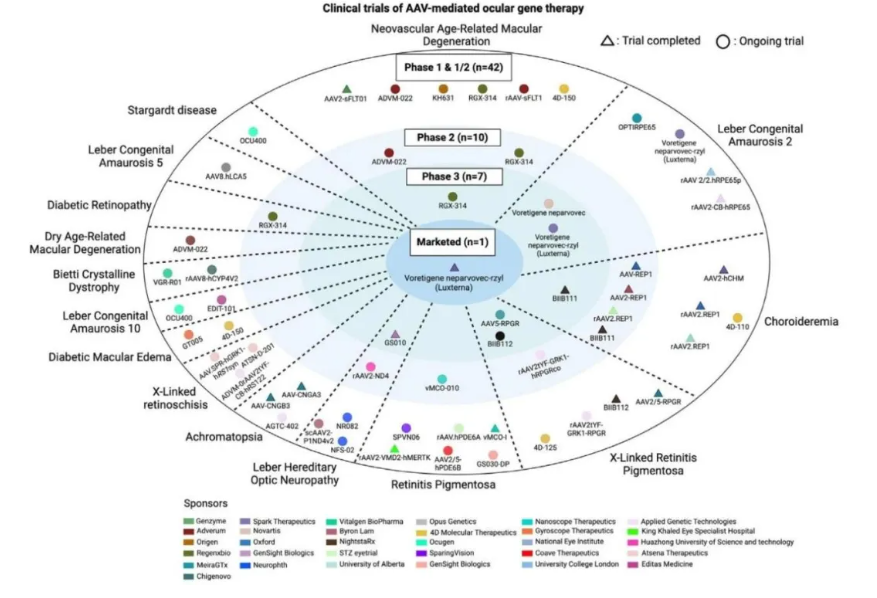
🎗Aromatic L-amino acid decarboxylase deficiency (AADCD)
rAAV2.AADC is a gene therapy strategy for the treatment of AADCD. AADCD is an autosomal recessive disorder caused by mutations in the dopa decarboxylase gene that results in serotonin and dopamine deficiencies. In 2012, four children with AADCD in Taiwan were treated with bilateral lenticular injection of rAAV2.AADC (1.6 × 10^11 vg), and all patients were found to have improved motor scores and subjective emotional stability. In a follow-up phase I/II trial of 10 patients, a slightly higher dose (1.81 × 10^11 vg) was used, and all patients experienced improved clinical motor function and cerebrospinal fluid (CSF) biochemistry. However, the patient developed transient dyskinesia after the infusion.
Recently, long-term follow-up results from the Taiwan trial reported significant improvement in 26 patients, three of whom were able to walk, and found that treatment age was inversely associated with exercise scores, but not with dose and scores. The most common treatment-emergent side effects (TEAEs) are fever and dyskinesia. Movement impairment was relieved in all but 1 patient, and the severity and duration of movement impairment were positively correlated with treatment age. The therapy (Eladocagene Exuparvovec) was finally licensed and approved by the European Medicines Agency for patients over 18 months of age (Upstaza).
🎗Spinal muscular atrophy (SMA)
Onasemnogene abeparvovec (Zolgensma) is a gene therapy used to treat SMA. SMA is an autosomal recessive disorder caused by loss-of-function mutations in the SMN1 gene. SMA type I is the most severe type, usually presenting within 6 months of life, and patients often die before the age of 2 years. In 2017, the results of the first clinical trials were announced, in which 15 patients received intravenous rAAV9-expressing SMN1 (rAAV9.SMN1) gene therapy, which showed a reduced need for ventilator support and an increase in exercise scores. Eleven patients were able to sit and stand for several seconds without the aid of external force and gained speech skills. Although the therapy is well tolerated, a common adverse effect is elevated hepatic transaminases, which are relieved with corticosteroids. Long-term follow-up results from the START trial, published in 2021, showed that patients maintained the motor skills acquired during the initial trial after a maximum follow-up of 6.2 years. Even more encouragingly, two patients reached new motor development milestones and were able to stand with assistance. In terms of safety, the results remained very positive, with no treatment-related adverse effects (TEAEs) reported.
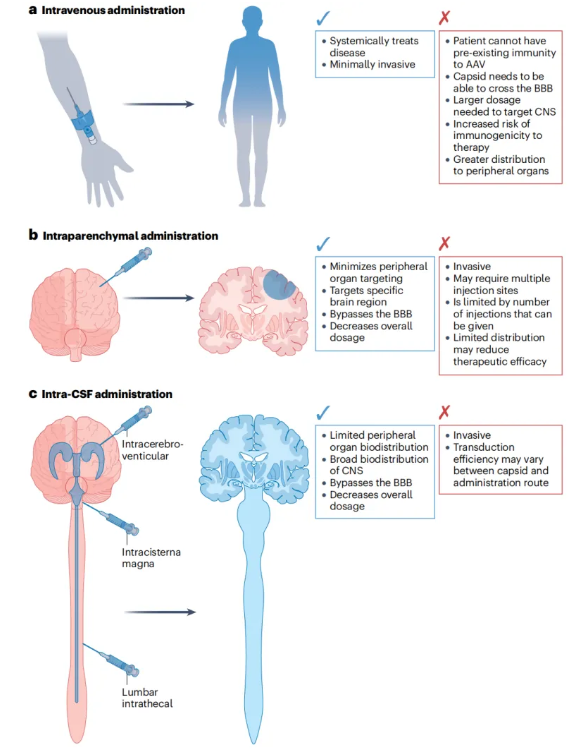
Figure 5: Route of administration of CNS gene therapy
🎗Tate-Sachs Disease (TSD) and Sandhoff Disease (SD)
rAAV.rh8 is a gene therapy strategy for the treatment of TSD and SD. TSD and SD are caused by mutations in the HEXA gene, which is a dimer composed of α and β (HEXA), β and β (HEXB), or α and α (HEXS) subunits, which result in ganglioside accumulation, and TSD and SD are caused by mutations in genes encoding α and β subunits, respectively. In 2022, an extension use trial in 2 patients with TSD demonstrated that the rAAV.rh8 vector expressed by intrathecal injection of two α and β subunits was safe and well tolerated by the procedure and vector, with both patients showing signs of stable disease. Currently, two ongoing clinical trials in Canada and the U.S. (project numbers NCT04798235 and NCT04669535, respectively) are evaluating the efficacy of rAAV9. The Phase I/II trial in Canada utilizes rAAV9 to deliver HEXA and HEXB transgenes to patients with infantile TSD or SD through a single intrathecal dose. In contrast, the U.S. trial was designed as a dose-escalation study, exploring four different vehicle doses through a bilateral thalamic route and intrathecal/cisternal combination administration. The study used two rAAV.rh8 vectors to deliver HEXA or HEXB transgenes, respectively, and the results of these trials have not yet been published.
🎗Canavan Disease (CD)
CD is caused by mutations in the ASPA gene, which leads to the accumulation of N-acetyl aspartate (NAA) in the central nervous system and urine. Currently, there are two clinical trials underway for CD, with trial numbers NCT04833907 and NCT04998396. The two trials used different vehicle designs and modes of administration (intracranial versus intravenous infusion), and different routes of administration inevitably led to differences in doses. Preliminary data from two trials show a positive treatment effect. As the two trials are still ongoing, a direct comparison of effects is not possible at this time.
🎗Hemophilia B
rAAV5 Padua (Hemgenix) is a gene therapy drug used to treat hemophilia B. HEMOPHILIA B IS CAUSED BY A DEFICIENCY OF COAGULATION FACTOR IX. (FIX.), WHICH IS PRODUCED IN LIVER CELLS. In 2009, researchers discovered the Padua variant of FIX, which has supraphysiological activity. In a phase I clinical trial, patients received a combination of the intravenously administered hepato-stimulating drug rAAV8 and an optimized codon hFIX transgene with FIX activity of 2-12% and no immunosuppression. In a subsequent study, the researchers designed a new engineered capsid with enhanced hepatropy, combined with the codon-optimized Padua FIX variant, with a corresponding dose reduction, and the FIX activity still reached an average of 33.7% (range 14-81%). In addition, only 2 patients were treated with prednisolone for transient elevated liver enzymes, showing a favorable safety profile. Based on these results, Hemgenix received FDA approval in 2023, becoming the first gene therapy approved for the treatment of hemophilia B.
🎗Hemophilia A
rAAV5hFVIIISQ (Roctavian) is a gene therapy drug used to treat hemophilia A. Hemophilia A is caused by a deficiency of coagulation factor VIII (FVIII), which is synthesized in endothelial cells. In a phase III clinical trial, patients received a single intravenous dose of rAAV5hFVIIISQ. The results showed that this one-time treatment significantly increased FVIII activity, reduced exogenous FVIII use, and improved bleeding events compared to routine prophylactic use of exogenous FVIII. However, over time, transgene expression declined. Despite this, Roctavian received FDA approval in 2023, becoming the first gene therapy approved for the treatment of hemophilia A.
rAAV.rh74.micro-dystrophin (Elevidys) is a gene therapy drug used to treat Duchenne muscular dystrophy (DMD). In 2020, a phase I/II trial evaluated the safety and efficacy of rAAV.rh74.micro-dystrophin administered intravenously at 2.0 × 10^14 vg/kg. The results showed improvement in clinical and histopathological manifestations in all patients, and correlated with age and disease severity at the time of treatment. In 2023, Elevidys received FDA approval, becoming the first gene therapy approved for the treatment of DMD.
In addition to gene replacement therapy, another treatment strategy is the use of disease-modifying genes. In 2022, a first-in-human trial treated two patients (6.9 and 8.9 years). In the experiment, bilateral femoral veins were used to isolate limb perfusion, and 5.0 × 10^13 and 2.5 × 10^13 vg/kg of rAAV.rh47 were injected into each leg to express the GALGT2 gene. No associated hepatotoxicity was reported, although antibodies against the rAAV capsid and mild rAAV and GALGT2 protein-specific T cell activity were detected. Notably, younger patients who received higher doses showed greater improvement. Other ongoing trials are still ongoing but are not recruiting new patients, including the randomized Phase I/II trial (NCT03368742) at Solid Bioscience and the non-randomized Phase Ib trial (NCT03362502) at Pfizer, both of which utilize rAAV9 to express truncated dystrophin under the control of a muscle-specific promoter.
In a phase I/II CUBIC trial, the effect of overexpressing SERCA2a with rAAV1 (rAAV1.SERCA2a) was evaluated. The results of the phase I study showed that some patients had improved symptoms and were well tolerated to treatment. In a further phase II study, a total of 25 treated and 14 placebo patients were included, and the treated patients showed a trend of improvement compared to those who received placebo; However, with the exception of left ventricular end-diastolic volume, most of the results did not reach a statistical difference, and the study confirmed the good safety profile observed in stage I. Subsequent three-year follow-up of CUPID phase II also failed to show an improvement in survival, but a statistically significant difference was reached in the cumulative analysis of non-terminal events.
The use of rAAV in humans is relatively limited, and only one trial (NCT02496273) of in vitro gene therapy for gastric cancer is currently ongoing. In a proof-of-concept study, rAAV-mediated interferon β (IFNβ) expression was used to inhibit the growth of colorectal cancer cells in a xenograft mouse model. The adaptability of rAAV can also improve transduction efficiency and specificity and mitigate adverse effects. For example, rAAV with a Her2 ligand increases transduction specificity. Expression of HSV thymidine kinase converts ganciclovir into a toxic product that is subsequently integrated into tumor DNA to induce cell death. This delivery modality reduced tumor burden and prolonged survival compared to the group of animals that received the anti-cancer drug Herceptin. However, this method is time-consuming and labor-intensive. Another approach is to screen the existing rAAV capsid repertoire and determine the best combination based on tissue affinity in different routes of administration. For example, rAAV7 and rAAV9 have been found to be highly efficient in transducing into mouse prostate tissue.
For example, in clinical trials at Luxturna and Zolgensma, some patients failed to achieve the desired response due to pre-existing NAbs. In addition, complement activation, innate immunity, and adaptive immune responses can also trigger adverse effects. For example, in Zolgensma's clinical trial, some patients developed thrombotic microangiopathy (TMA). To address these issues, researchers are exploring a variety of strategies, including the use of immunosuppressive drugs and the design of engineered capsids. For example, the use of drugs such as steroids, rituximab, and rapamycin can effectively suppress the immune response. In addition, optimizing the AAV capsid through computer-aided design and machine learning can improve transduction efficiency and tissue specificity, thereby reducing the immune response.
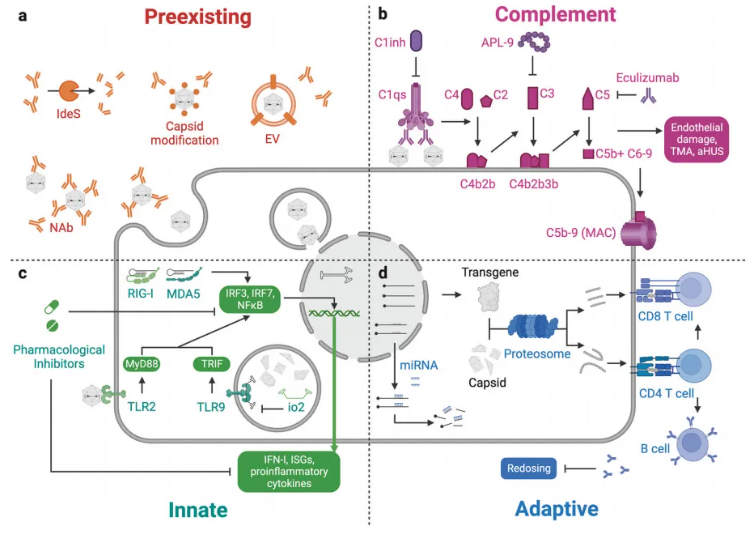
Figure 6: Immune response in rAAV-based gene therapy
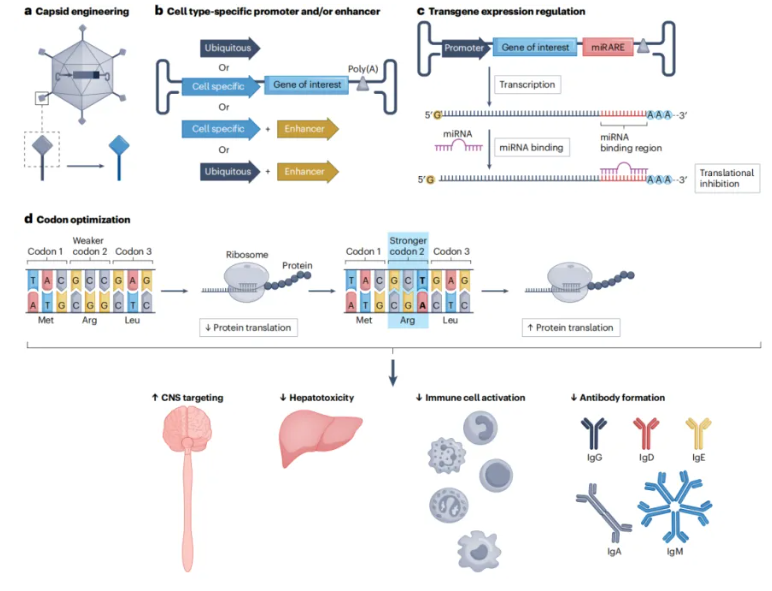
🌸Summary
AAV gene therapy has shown great potential in a variety of diseases, but challenges remain in terms of immune response, long-term efficacy and safety, and manufacturing complexity. By optimizing vector design, developing more efficient manufacturing platforms, and exploring precision medicine strategies, AAV gene therapy is expected to become an important means for the treatment of a variety of hereditary and complex diseases in the future.
🌸References
[1] Wang JH, Gessler DJ, Zhan W, Gallagher TL, Gao G. Adeno-associated virus as a delivery vector for gene therapy of human diseases. Signal Transduct Target Ther. 2024 Apr 3; 9(1):78. doi: 10.1038/s41392-024-01780-w. PMID: 38565561; PMCID: PMC10987683.
[2] Wang JH, Zhan W, Gallagher TL, Gao G. Recombinant adeno-associated virus as a delivery platform for ocular gene therapy: A comprehensive review. Mol Ther. 2024 Dec 4; 32(12):4185-4207. doi: 10.1016/j.ymthe.2024.10.017. Epub 2024 Oct 28. PMID: 39489915; PMCID: PMC11638839.
[3] Ling Q, Herstine JA, Bradbury A, Gray SJ. AAV-based in vivo gene therapy for neurological disorders. Nat Rev Drug Discov. 2023 Oct; 22(10):789-806. doi: 10.1038/s41573-023-00766-7. Epub 2023 Sep 1. PMID: 37658167.
Brain Case offers various customization and viral packaging services. Please contact us for more information and consultation at: bd@ebraincase.com